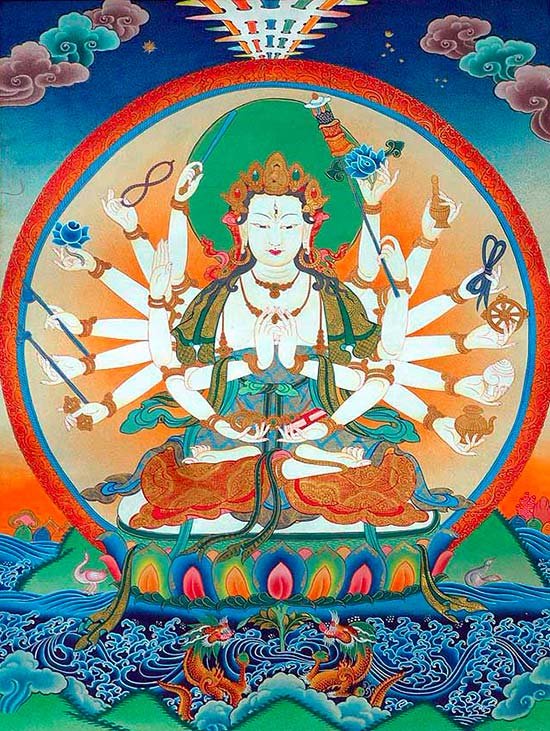Maha Prajnaparamita Sastra
by Gelongma Karma Migme Chödrön | 2001 | 941,039 words
This page describes “imitating the bearing of the buddha” as written by Nagarjuna in his Maha-prajnaparamita-sastra (lit. “the treatise on the great virtue of wisdom”) in the 2nd century. This book, written in five volumes, represents an encyclopedia on Buddhism as well as a commentary on the Pancavimsatisahasrika Prajnaparamita.
Part 9 - Imitating the bearing of the Buddha
Sūtra (cf. Pañcaviṃśati, p. 32, l. 18; Śatasāhasrikā, p. 110, l. 13–14). – Furthermore, O Śāriputra, the bodhsattva-mahāsattva who wishes to imitate the bearing of the Buddha must practice the perfection of wisdom (Punar aparaṃ Śāriputra bodhisattvena mahāsattvena tathātagateryāpathaṃ śikṣitukāmena prajñāpāramitāyāṃ śikṣitavyam).
Śāstra. –
Question. – What is the bearing (īryāpatha) of the Buddha?
Answer. – The bearing is the four physical movements or postures: [walking (caṅkrama), standing (sthāna), sitting (niṣīdana) and lying down (śayyā)[1]].
1. Walking (caṅkrama)
Like the king of the elephants (nāgarāja), the Buddha turns his body in order to look.[2]
When he walks, his feet are four inches (caturaṅgulam) above the ground and, although he does not set foot on the ground, the traces of the wheel on his soles are visible [on the earth] (see notes below).
He walks neither too slowly nor too quickly.[3]
He does not bend his body.[4]
He always raises his right hand to reassure beings.
2. Sitting posture (niṣīdana)
He sits cross-legged with his body upright.[5]
3. Lying down posture (śayyā)
[310a] He always lies down on his right side and places his knees one on top of the other.[6]
The mat of grass that he spreads out is well arranged and not disordered.[7]
4. Manner of eating (bhojana)
When he eats, he is not attached to the taste; for him, good and bad food are the same.[8]
5. Manner of speaking (ghoṣa)
To accept an invitation from people, he keeps silent and does not refuse.[9]
His speech is gentle (mañju), skillful, beneficial and timely.[10]
Final notes:
As for the postures (īryāpatha) of the dharmakāya Buddhas, they are: In one single stride (ekena padena), they traverse, in the east, universes as many as the sands of the Ganges, and the sermons (dharamdeśana) of their brahmic voice (brahmasvara) has the same range.
For the characteristics of the dharmakāya Buddhas, see what has been said above (p. 546F).
Notes on the Footprints of the Buddha:
Loke sutta of Anguttara, II, p. 37–39; Saṃyukta, T 99, no. 101, k. 4, p. 28a20–b18 and T 100, no. 267, k. 13, p. 467a26–b24; Ekottara, T 125, k. 31, p. 717c18–718a12:
In the land of Kosala, mid-way between Ukkaṭṭhā and Setavyā, the brāhmaṇa Doṇa saw footprints on the ground [read padesu in place of pādesu: according to the Commentary of the Anguttara, III, p. 77, pada is rather a place trodden by the feet (pādehi akkanataṭṭhāna), a footprint (padavajaḷañja)]. On these footprints there were thousand-rayed wheels with rims and all of the attributes (cakkāni sahassarāni sanābhikāni sabbākāraparipūrāni). Doṇa told himself that these prints could not have been made by a man. He followed them and finally saw the Buddha seated at the foot of a tree. Struck by the dignity of the Teacher, he asked him if he were a deva, a gandharva, a yakṣa or a man. To all these questions the Lord answered in the negative and presented himself as Buddha. It was then that he pronounced this famous phrase which the Lokottaravādins later blew up out of proportion: Seyyathāpi uppalam… evam eva kho loke jāto loke saṃvaḍḍho lokam abhibhuyya viharāmi anupalitto lokena.
We may notice that the Chinese versions mentioned here reproduce this phrase only very incompletely.
On the footprints of the Buddha, see Hōbōgirin, II, p. 187, s.v. Bussokuseki; Ceylon Encyclopedia, III, p. 450, s.v., Buddhapāda.
Footnotes and references:
[1]:
According to the well-known stock phrase: Caturvidham īryāpathaṃ kalpayati caṅkramati tiṣṭhati niṣīdati śayyāṃ kalpayati: Catuṣpariṣad, p. 318; Divyāvadāna, p. 161.
[2]:
Cf. Majjhima, II, p. 137: Avalokento kho pana so bhavaṃ Gotamo sabbakāyen’ eva avaloketi. This is a polite gesture.
[3]:
Majjhima, II, p. 137: So nātisīghaṃ gacchati nātissaṇikaṃ gacchati.
[4]:
Majjhima, II, p. 137: So antaragharaṃ pavisanto na kāyaṃ unnāmeti, na kāyaṃ onāmeti, na kāyaṃ sannāmeti, na kāyaṃ vināmeti.
[5]:
Dīgha, I, p. 71; Majjhima, I, p. 56; Saṃyutta, I, p. 170; Anguttara, II, p. 210: So pacchābhattaṃ piṇḍapātapaṭikkanto nisīdati pallaṅkaṃ ābhujitvā ujuṃ kāyaṃ paṇidhāya parimukhaṃ satiṃ upaṭṭhapetvā. – Sanskrit Parinirvāṇa, p. 268, 288: Nyaṣīdat paryaṅkam ābhujyarjuṃ kāyaṃ praṇidhāya pratimukhaṃ smṛtim upathāpya.
[6]:
Dīgha, II, p. 134; Majjhima, I, p. 354; Saṃyutta, I, p. 27, 107: Bhagavā dakkhiṇena passena sīhaseyyaṃ kappesi, pāde padaṃ accādhāya sato sampajāno uṭṭhānasaññaṃ manasikāritvā. – Sanskrit Mahāparinivāṇa, p. 266, 286, 294: Bhagavān dakṣiṇena pārśvena śayyāṃ kalpayati pāde pādam ādhāyālokasaṃjñī pratismṛtaḥ saṃprajāna utthānasaṃjñāṃ mansaikurvāṇaḥ.
[7]:
Anguttara, I, p. 183: So yad eva tattha honti tiṇāni vā pāṇṇāni vā tāni ekajjhaṃ saṃharitvā nisidāni pallaṅkaṃ ābhuñjitvā.
[8]:
Majjhima, II, p. 138: Rasapaṭisaṃvedi kho pana so bhavaṃ Gotamo āhāraṃ āhāreti, no ca rasarāgapaṭisaṃvedī.
[9]:
Majjhima, I, p. 161; Saṃyutta, I, p. 183: Adhvāsesi Bhagavā tuṇhībhāvena. – Catuṣpariṣad, p. 194; Sanskrit Mahāparinirvāṇa, p. 144; Divya, p. 151: Adhivāsayati Bhagavān … tūsṇīmbhāvena.
[10]:
Cf. Majjhima, II, p. 140: Aṭṭhaṅgasamannāgato kho pan’ assa bhoto Gotamassa mukhato ghoso niccharati, vissaṭṭho ca viññeyyo ca mañju ca savanīyo ca bindu ca avisāri ca ninnādī ca.
